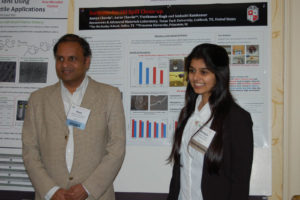AATCC conference focuses on sustainability and innovations.
By Seshadri Ramkumar, Ph.D.
The historic city of Savannah, Ga., hosted a gathering of more than 200 people who participated in deliberations on the latest developments in consumer trends, textile chemicals, fiber and material innovations. This year’s American Association of Textile Chemists and Colorists (AATCC) Conference had three distinct tracts: concept-to-consumer issues, chemical applications and materials. There were 44 papers and poster presentations as well. Sustainability and innovation in the fiber-to-fashion supply chain were the event’s main focus.
Technical textiles types
The conference began with my detailed tutorial, “Technical Textiles,” in which I presented a classification system for technical textiles to spearhead the growth of this sector, not only in the developed nations, but also in developing countries such as Brazil, India and China.
Generally, industrial textiles can be classified in three types: consumer products, institutional products and regulated/government procurement products. This simple classification will encompass the 12 categories proposed at Messe Frankfurt-TechTextil some time ago, and it makes it easy for entrants in the field of industrial textiles to focus on diversification from their existing conventional products.

Sustainability in the industry
Sustainability is taken seriously by both conventional and industrial textiles sectors. This became even clearer in the keynote lecture, “Doing Well or Just Looking Good?” by Kevin Myette, North American director of the Switzerland-based bluesign® system.
Admitting that he is neither a chemist nor a technologist, but one who knows how products are made and brands operate, he explained that the textile supply chain is complex like a web, so understanding the entire supply chain—from raw materials and suppliers, to brands and retailers—matters a lot these days; it is important to identify and eliminate the use of unsafe chemicals prior to production, Myette said. In other words, one has to be proactive rather than reactive.
The technical textiles sector could find much that is useful in Myette’s talk—for example, understanding the chemistry of chemicals is important, and testing is a method and not a solution. In response to my question, he also said that cost is part of the equation but not an excuse. Sustainability is a means and not an end toward the next phase of the textiles sector.
Peter Hauser, immediate past president of AATCC and professor of textile chemistry at North Carolina State University, also focused on this topic, providing an overview on machines and developments that focus on sustainable wet processing. Because 25 percent of chemicals manufactured in the world go to textiles, it is important that the textile industry embrace sustainable practices.
Hauser pointed out some key developments in the industry: the development of PLA fiber, which is registering a phenomenal growth of 20 percent; use of enzymes in textile processing; and hydrogen peroxide activators that reduce the temperature of processing that can lead to energy savings.
Omniphobic military textiles
A new development in the protective textiles sector was presented by Quoc Truong, Ph.D. of the U.S. Army Natick Soldier Center. His talk focused on omniphobic textiles, which will provide both hydrophobic and oleophobic properties to army combat uniforms. The chemistry Dr. Truong used involves low surface tension fluorodecyl polyhedral oligomeric silsesquioxane (POSS) developed by the U.S. Air Force.
Plasma chemistry
The fourth state of matter involving ions, plasma is used to modify textile chemistry and surfaces without affecting inherent and bulk properties. Over the years this technology has been developed from being a batch process to continuous process with the advent of delivering plasma chemistry at atmospheric pressure. This has enabled the textile industry to consider plasma as pretreatment and functionalizing processes.
Professor Majid Sarmadi of the University of Wisconsin-Madison presented his work on low pressure plasma-based, flame-retardant cellulosic materials. Sarmadi is one of the pioneers in the country on the use of plasma approaches in textiles. He presented his study on cross-linking sodium silicate to cotton using oxygen plasma to provide durable flame retardancy for cotton fabrics. Oxygen plasma-treated cotton samples were easily able to self-extinguish the flame and could withstand 50 laundry cycles, showing that plasma technology can serve as a viable, environmentally friendly functionalization tool for developing advanced textiles.
Texas Tech University and India-based Avinashilingam University for Women are doing collaborative research focused on the use of natural herbs from Guava leaves and prickly chaff flowers to impart antimicrobial properties to textiles using plasma as an enhancer. This, again, showcased the trend in the industry toward sustainable approaches to developing next generation textiles.
Along these lines, Dr. Robert Monticello of the International Antimicrobial Council and president of global antimicrobials provider, Consolidated Pathways Inc., presented an overview on the subject of antimicrobial activity and testing. This presentation will certainly be useful for the technical textiles industry that concentrates on medical, hygiene and wipes sectors.
Medical textiles
Medical and hygiene are certainly growth sectors, and new textile-based materials are evolving for use both outside and within the human body. Dr. Walter Chappas of Herty Advanced Materials Center at Georgia Southern University presented new developments, such as winged fiber and segmented pie nonwoven structures that find applications as bio-scaffolds. Spunmelt nonwoven processes are effectively utilized by the industry to develop new filtration and biomedical products that could help the pharmaceutical and filtration industries.
Cotton and PCMs
Renuka Dhandapani from Cotton Inc. presented work on incorporating phase-change materials and inorganic materials into cotton to have good thermal regulation. Phase-change materials (PCMs) and inorganic coating to cotton have been shown to make it superior in thermal properties.
The need for innovation
The need for innovation, both in process and products, was clear in this conference. Joe Walkuski of TEXbase Inc., Bozeman, Mont., emphasized the need for integrating technology to develop quality material, and for quality and compliance to advance in friendly coexistence.
Generally, the conference effectively showcased useful innovations and provided clues for product development using sustainable approaches by showing that sustainability should involve not only materials but also process improvements, operational efficiency and harmony between regulation and quality aspects.
Seshadri Ramkumar, Ph.D., FTA (Honorary), is a professor at the Nonwovens & Advanced Materials Laboratory at Texas Tech University, Lubbock, Texas.
 TEXTILES.ORG
TEXTILES.ORG


